Use 'Print preview' to check the number of pages and printer settings.
Print functionality varies between browsers.
Printable page generated Saturday, 29 November 2025, 10:48 AM
Study Session 7 Distribution, Leakage and Illegal Connections
Introduction
Some of the principles of distribution and delivery of water in urban areas were explained in Study Session 1. Water from a treatment plant is conveyed in transmission mains to service reservoirs, and then in distribution mains that deliver it to consumers.
In this study session you look at this system again and consider the causes and effects of leakage and the ways it can be detected. You will also consider illegal connections to the water supply system, and the impacts that they have.
Learning Outcomes for Study Session 7
When you have studied this session, you should be able to:
7.1 Define and use correctly all of the key words printed in bold. (SAQ 7.1)
7.2 Describe drinking water delivery options in urban settings. (SAQ 7.2)
7.3 Explain what leakage is, how it is detected and how it can be reduced. (SAQ 7.3)
7.4 Describe the problems created through illegal connections to a water main. (SAQ 7.4)
7.1 Water delivery in urban settings
Water in urban areas is usually conveyed through a network of pipes to reach the users. Figure 7.1 is a diagram of a typical distribution and delivery system.
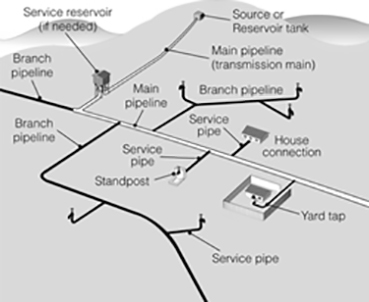
Compare Figure 7.1 with Figure 1.10 in Study Session 1. Which parts of the system can you see in both diagrams?
The transmission main and service reservoir are in both diagrams. The treatment works in Figure 1.10 is equivalent to the ‘Source’ here. The distribution mains are shown in Figure 7.1 as the main and branch pipelines.
Figure 7.1 also shows the further distribution options labelled as ‘house connection’ (indoor taps), ‘yard tap’ (outside the house) and ‘standpost’. Standposts or standpipes are equivalent to public taps and water points. Water can also be obtained from kiosks, which are booths selling, in addition to water, food, household items, etc. The junctions in the system, where one pipe connects to another, should be controlled by valves so that water flow can be managed in the separate sections and different parts can be isolated. This allows repairs to be made to one section without cutting off the supply elsewhere.
In some cases, in order to reach the extremities of the distribution system the water may have to be pressurised and pumped. Pressurising the water also prevents entry of contaminants should there be a crack in the pipe.
In flat areas of the country, certain structures are used to ensure the water can flow by gravity to users. What are these structures?
Water towers.
The pipework of a distribution system can be made of different materials. In the old days pipes were often made of metal, but nowadays it is very common to see polyethylene or other types of plastic pipes. Plastic pipes can last in excess of 100 years (Plastics Industry Pipe Association, n.d.) and do not suffer from corrosion as metal pipes do. Corrosion is the gradual destruction of materials (usually metals) by chemical reaction with their environment. Corrosion in pipes leads to a reduction in their water-carrying capacity, so that the water requires greater pumping (thus consuming more energy). In addition, when metal pipes corrode they release metals into the water, causing undesirable aesthetic and health effects. When unlined iron pipes are used, iron can be released and this causes the water to appear brown or red. Washing light-coloured clothes with this water leaves a stain. Plastic pipes are lighter and therefore easier to transport, and they are also easier to lay (Figure 7.2).
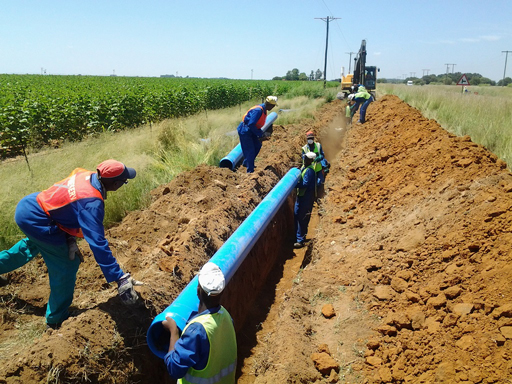
7.2 Non-revenue water and leakage
Water that is supplied by water utilities has to be paid for, since the production and distribution of treated water costs money. (You will learn more about this in Study Session 13.) There is, however, a category of water supplied from which no income is derived for the water utility. This non-revenue water includes:
- water that is used by the water utility for maintenance purposes, for example for cleaning out pipes, reservoirs or tanks
- water that is not recorded as having been used, due to inaccurate or faulty water meters
- water that is taken illegally from the mains
- water that is lost due to leakage (water escaping from the pipe into the environment).
Leakage is by far the biggest component in non-revenue water. In Addis Ababa, for example, non-revenue water is estimated to be 41% of the total volume supplied (GWOPA, n.d.). A figure of 10% for non-revenue water is acceptable – anything higher needs investigating. Figure 7.3 shows an example of water being lost via a burst pipe. Many water leaks, unlike the one shown here, are slow and relatively small. They can be unobtrusive and not visible at the surface but, over time, large volumes of water can seep out of a leaking water pipe and into the surrounding ground.
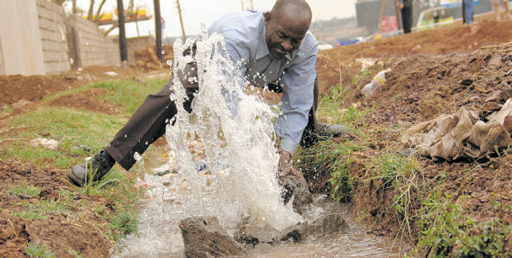
Why do you think water leakage from an urban distribution system is a problem?
Leakage means that good-quality water produced in a treatment plant is lost. The cost of the water is an issue but, more importantly, it results in less water being available for supply. It can mean that customers are left without water for some of the time. This could make it difficult for them to wash and thus potentially affects their health.
In the long term, the loss of water due to leakage puts added pressure on the water supply system. Increasing demand from rising urban populations requires the expansion of existing water supply systems or the development of new ones, which is costly and challenging. Preventing leakage in the existing system rather than investing in expansion or new schemes would be economically preferable.
Leakage causes many other problems. It leads to a loss in pressure in the water supply system. To overcome this the operators may then increase the pressure (using more energy) but this increased pressure leads to a greater rate of leakage. Leaking water can damage infrastructure such as the foundations of buildings. In addition, damaged pipes can allow contamination of the mains supply. The reduction in water pressure (in the underground pipe) will allow impure water from the soil to get into the water main and contaminate the supply.
There are several different reasons why water pipes leak and they frequently occur in combination. Leakage occurs due to the pipelines:
- being old and corroded, like the section shown in Figure 7.4
- being poorly constructed, where sections of pipe are not joined properly to each other
- being poorly maintained
- having poor corrosion protection
- being damaged through digging by other utilities
- being damaged by aggressive (corrosive) water inside the pipe, when water quality standards are breached
- being damaged through illegal connections made to the pipe (discussed in Section 7.5).
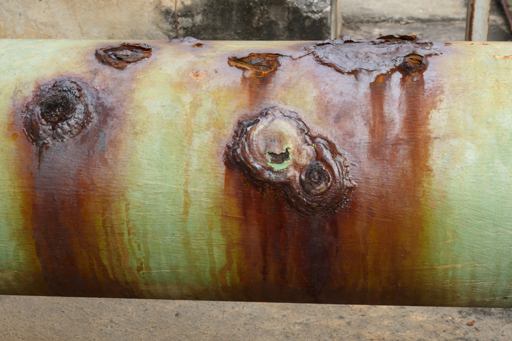
Any pipework is vulnerable to pollutants in the soil and ground on the outsideof the pipe, which can be corrosive, depending on several factors including the use of the surrounding land, the presence of industrial wastes that can leach through the soil, etc. The water inside the pipe that is being delivered to customers should, of course, be potable and free of any undesirable pollutants. However, if there is a failure in the system, it is possible that the water may become corrosive, attacking pipe and storage tank material. Water that is acidic, has a high dissolved solids content or is very hot can be corrosive.
2Responsibility for leakage control in main water pipelines lies with the water utilities. Each water utility must have a code of practice that sets out how they address any leakage in water supply pipes. The following procedure is generally adopted once a leak has been detected:
- Assess the damage to the pipework.
- Identify the resources (human, time and materials) needed to rectify the problem.
- Mobilise resources.
- Let customers know about the extent of the damage and the time needed to resolve the problem.
- Provide an alternative water supply until the restoration work has been completed.
- Undertake the repairs and reconstruction work as rapidly as possible.
7.3 Leakage prevention, detection and control
Although leaks can occur through valves that are malfunctioning, the largest losses of water are through leaks in the water main itself, either where two sections are joined or where there is a defect in the pipe. Proactive leakage control (where teams take action to prevent leaks occurring) can bring several benefits. It will mean that more water is available for supply, and it will delay the need for costly expansion programmes. It will also lead to less disruption of traffic and daily life, which happens when a leakage is discovered and has to be fixed. Less infrastructure damage is caused and there is less risk of the mains water becoming contaminated.
One way to minimise leaks is to ensure that the water pressure in the distribution system is not excessive. Lowering the system pressure during periods of low water demand can lead to a decrease in leakage loss, and extend the life of pipes (Thompson and Wang, 2009). Another form of proactive leakage management is to replace ageing pipes as they reach the end of their life.
7.3.1 Detecting leaks in water mains
Preventing leaks by using corrosion-resistant materials, following the correct procedures for pipe laying, and conducting regular checks and preventive maintenance is the best approach, but inevitably some leaks will still occur. The challenge is to find the leaks, which will probably be underground, and repair them as quickly as possible. This is active leakage control.
Leaks are usually detected from the sound generated by the escaping water. A device called a noise correlator (Figure 7.5) is used to listen to the leak from two different points and can pinpoint the exact location of the leak. The correlator can be used on both metal and non-metal pipes.
Typically, microphones or acoustic sensors (1 and 2 in Figure 7.5) are placed in contact with the pipe, at two points, to record the hissing sound emitted by a leak somewhere between the points. The sound data are sent to a noise correlator (3), which processes the information through a mathematical program to determine the difference in the times taken for the noise to travel from the site of the leak to each of the sensors. If the distance between the sensors is known, this timing information can be used to determine the location of the leak.
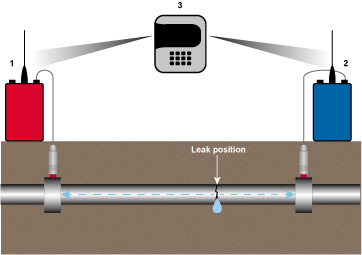
Leakage detection is best carried out at night when it is quiet and the use of water is minimal. Sections of pipe which have a high flow can then be closed off and investigated for leaks. In areas where there is only an intermittent supply of water, a water tanker can be used to put water into a section of pipe and pressurise it. Any leakage can then be easily detected.
Alternatively, devices called acoustic loggers (Figure 7.6) can be attached to pipes using magnets. They record and analyse the intensity and consistency of noise in the pipe. A significant change in the noise will signal a leak. This device has been used in Harar to detect leaks (Mohammed, 2015). A combined correlator-acoustic logger is also available. This reduces the time for detecting and pin-pointing a leak.
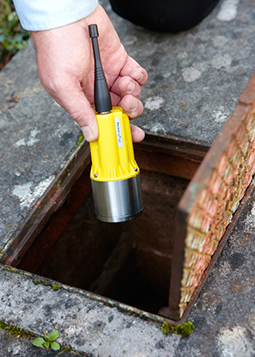
Another device is ground-penetrating radar, which reveals leaks by identifying disturbed ground or cavities around a pipe. It can be used to locate leaks where a correlator would be impractical due to noise created by pumps, etc.
Contrary to common belief, large leaks that spray water into the street, like the one in Figure 7.4, are not the major cause of water loss, since they are obvious and thus quickly found and repaired. The small leaks, which discharge water under the ground, are not obvious and can remain undiscovered for years, with the concomitant loss of a large amount of water. However, in a pressurised system, small leaks are noisy and can be detected easily, once suspicion is aroused about a possible leakage.
When carrying out a leak detection programme, it is best to concentrate on parts of the distribution system that are most likely to have a leak. These would be:
- areas where there have been leaks before
- areas where there is heavy traffic, because this would exert a load on the pipes, and also the vibrations caused by the traffic can cause damage.
Once a leak is discovered it has to be repaired quickly, so that wastage of water and money is avoided. Public opinion is also important – water seen gushing out onto the street for a long period quickly leads to accusations that the water utility is being complacent!
Special collars that fit around the pipe are used to repair small leaks. For large leaks, a smaller-diameter pipe may be inserted into the section of pipe concerned, so that the water flows through this new pipe (effectively a pipe within a pipe). Alternatively, the pipe section itself can be replaced.
7.3.2 Detecting leaks at home
For homes with a piped water supply, if the water bill suddenly goes up when the circumstances in the home have not changed, it is a sign that perhaps there is a leak in the water system. A way of confirming this is to turn off all the water appliances and observe the water meter. If the dials on it are turning, there is a leak somewhere. It may be possible to hear the hissing noise of water escaping. A search for the source of the sound will reveal the leak.
Water-flushed toilet systems can be checked by putting a few drops of food colouring in the water tank of the cistern, and 30 minutes later checking the water in the toilet bowl. If it has colour in it, the cistern is leaking.
7.4 Illegal connections
There are cases in Ethiopia and many other places of people illegally tapping into a water main in order to obtain water without paying for it. The cost of the water they use is borne by others who do pay for the water produced by the utility. Apart from committing a crime (theft of water, thus depriving the water utility of revenue), people who make illegal connections to the water supply system also endanger the safety of the mains water through possible contamination. This can be caused simply by making a break in the pipe without taking the necessary precautions to prevent contamination. The same can also happen if the illegal connection consists of a hose or pipe that, at one end, is connected to the water main and, at the other end, is left immersed below the water level of a storage tank, bucket or other container. This situation is illustrated in Figure 7.8. If there is a reduction in water pressure in the water main (say, due to a pipe burst), water from the container could be drawn into the mains supply. This phenomenon is referred to as back-siphonage. If the water in the bucket is contaminated in any way, this will result in contamination of the mains water too.
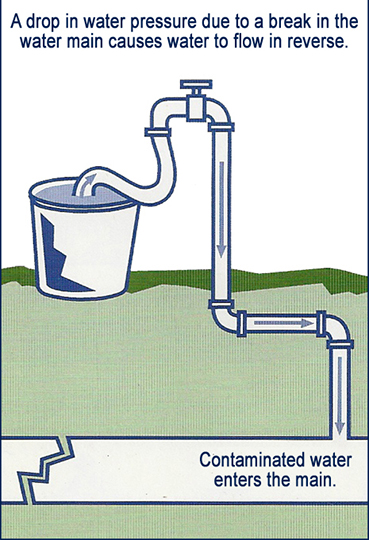
Illegal connections mainly occur in newly established residential areas where some of the newly built households are supplied with water from the mains, while others do not have a piped supply. They get water from their neighbours through illegal connections using water hoses or plastic and metal pipes, without the knowledge and authorisation of the water utility.
7.5 Sustainability
The sustainability of a water distribution and supply system will be improved if pipes are made of robust, long-lasting material. The laying of the pipes has to conform with good civil engineering practice so that leaks are prevented. The pipes should not be laid where excessive pressure or vibration from above (such as from road traffic) is present. Maintenance of the distribution system is paramount, with proactive leakage control, and repair and replacement of pipes, etc. when appropriate. The sustainability of the whole water supply system can be improved if leakage is minimised and illegal connections are eliminated. Sustainability will also be enhanced if the volume of potable water used for purposes other than personal consumption is minimised. You will learn about ways of using less water in Study Session 11.
Summary of Study Session 7
In Study Session 7, you have learned that:
- Drinking water distribution systems take water to indoor taps, taps in yards and public taps.
- Water pipes are now mainly made of plastic that last at least 100 years, and they are easier to transport and lay than metal pipes.
- Care must be taken when handling water so as not to contaminate it.
- Non-revenue water is water from which no income comes to the water utility. This includes water that is used by the water utility in its operations, water that is not recorded as used, water that is stolen through illegal water connections and water that is lost by leakage.
- Leakage, the biggest portion of non-revenue water, results in lost revenue, less water being available for supply, and damage to infrastructure.
- Leakage occurs when pipelines are old and corroded, badly constructed, poorly maintained and damaged externally by digging or internally by aggressive water.
- Leakage control can be proactive or active using equipment such as correlators, acoustic loggers, and ground penetrating radar. There are simple methods available to discover water leaks in the home. Illegal connections deprive water utilities of income, and can result in the contamination of water mains through back-siphonage.
- Sustainability in water distribution and supply can be ensured by using robust, long-lasting pipes, laid appropriately, in locations where the pressure on the pipes and vibration are minimised. Maintenance, leakage control, the elimination of illegal connections and the minimisation of water use will also contribute to sustainability.
Self-Assessment Questions (SAQs) for Study Session 7
Now that you have completed this study session, you can assess how well you have achieved its Learning Outcomes by answering these questions.
SAQ 7.1 (tests Learning Outcome 7.1)
Match the following words to their correct definitions.
Two lists follow, match one item from the first with one item from the second. Each item can only be matched once. There are 9 items in each list.
leakage
noise correlator
active leakage control
corrosion
back-siphonage
proactive leakage control
ground penetrating radar
non-revenue water
acoustic logger
Match each of the previous list items with an item from the following list:
a.the drawing of external water into a water main as a result of a reduction in pressure in the water main
b.a device that is used at two points to pinpoint leaks through the sound that is generated by water escaping
c.the process whereby a metal gets weaker due to a reaction with its environment
d.water from which no income is received
e.searching for leaks and repairing them
f.taking action to prevent leaks from occurring
g.a device used to detect leaks by identifying where the ground has cavities, or has been disturbed
h.the escape of water from pipes or other parts of the water distribution system
i.a device attached to a pipe that can indicate a leak when the noise in the pipe changes
- 1 = h,
- 2 = b,
- 3 = e,
- 4 = c,
- 5 = a,
- 6 = f,
- 7 = g,
- 8 = d,
- 9 = i
SAQ 7.2 (tests Learning Outcome 7.2)
List the ways by which municipal water reaches consumers in urban areas of Ethiopia served by a distribution system.
Answer
Water reaches the consumers through indoor taps, taps in the yard, public taps and water kiosks.
SAQ 7.3 (tests Learning Outcome 7.3)
Which of the following is not a cause of leakage? Give your reason why.
- a.excessive pressure in the pipes
- b.poorly-constructed distribution systems
- c.illegal connections
- d.old, corroded pipes
- e.pipes damaged due to construction of roads, etc.
Answer
The answer is c. An illegal connection is loss of water through theft, and not through leakage.
SAQ 7.4 (tests Learning Outcome 7.4)
Which of the following statements relating to illegal connections is false? Give the reason for your choice.
Illegal connections result in:
- A.the possibility of the mains supply becoming contaminated
- B.an increase in the quantity of non-revenue water
- C.greater revenue for the water utility because more water is used
- D.a crime, since water is being stolen
- E.an increase in the financial burden to those people who do pay for water used.
Answer
The answer is C, because the people who use water from illegal connections don’t pay for the water.